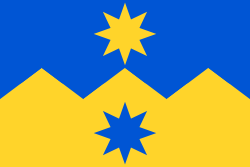
Flag of Otago
Encyclopedia

Otago
Otago is a region of New Zealand in the south of the South Island. The region covers an area of approximately making it the country's second largest region. The population of Otago is...
is one of the few regions of New Zealand
New Zealand
New Zealand is an island country in the south-western Pacific Ocean comprising two main landmasses and numerous smaller islands. The country is situated some east of Australia across the Tasman Sea, and roughly south of the Pacific island nations of New Caledonia, Fiji, and Tonga...
to have officially adopted a flag.
Otago has long been associated with several symbols and colours. The St. Andrew's Cross
Saltire
A saltire, or Saint Andrew's Cross, is a heraldic symbol in the form of a diagonal cross or letter ex . Saint Andrew is said to have been martyred on such a cross....
is one such symbol, in recognition of the former province's
Provinces of New Zealand
The Provinces of New Zealand existed from 1841 until 1876 as a form of sub-national government. They were replaced by counties, which were themselves replaced by districts.Following abolition, the provinces became known as provincial districts...
Scottish
Scotland
Scotland is a country that is part of the United Kingdom. Occupying the northern third of the island of Great Britain, it shares a border with England to the south and is bounded by the North Sea to the east, the Atlantic Ocean to the north and west, and the North Channel and Irish Sea to the...
settlement. Another, used on the original arms of the province, is the eight-pointed star.
Traditionally, the province (as the region is still called) has always been associated with the colours blue and gold, these colours representing Otago's original foundation, on the wealth of gold
Gold
Gold is a chemical element with the symbol Au and an atomic number of 79. Gold is a dense, soft, shiny, malleable and ductile metal. Pure gold has a bright yellow color and luster traditionally considered attractive, which it maintains without oxidizing in air or water. Chemically, gold is a...
taken from the rivers of the province during the 1860s gold rush. The blue also again harks back to the flag of Scotland
Flag of Scotland
The Flag of Scotland, , also known as Saint Andrew's Cross or the Saltire, is the national flag of Scotland. As the national flag it is the Saltire, rather than the Royal Standard of Scotland, which is the correct flag for all individuals and corporate bodies to fly in order to demonstrate both...
.
For many years, these colours were seen in a wide variety of different designs intended to represent Otago. Popular designs included flags quartered in blue and gold, or in blue with a gold saltire
Saltire
A saltire, or Saint Andrew's Cross, is a heraldic symbol in the form of a diagonal cross or letter ex . Saint Andrew is said to have been martyred on such a cross....
. A vertically divided design in blue and gold with the word "Otago" in white fimbriated
Fimbriation
In heraldry and vexillology, fimbriation refers to small stripes of colour placed around common charges or ordinaries, usually in order for them to stand out from the background, but perhaps just because the designer felt it looked better, or for a more technical reason to avoid what would...
in black was also popular and can still be seen in use in the province.
In 2004, a campaign was started by prominent local author and regional councillor Neville Peat
Neville Peat
Neville Peat is a Dunedin-born New Zealand author and photographer, based at Broad Bay on the Otago Peninsula. He specialises in topics about natural history, notably that of southern New Zealand and New Zealand's sub-antarctic islands...
to decide on a design for a flag for the region as a whole (and more specifically for use by the Otago Regional Council
Otago Regional Council
Otago Regional Council is the regional council for the Otago region in the South Island of New Zealand. The council's principal office is Regional House on Stafford Street in Dunedin, with smaller offices in Queenstown and Alexandra....
).
The design (chosen in late 2004 from several hundred entries submitted) was designed by Gregor Macaulay. It is blazoned Per fess dancetty azure and or, two mullets of eight points in pale counterchanged. The design represents the blue skies over the hills of Otago separated by a zigzag dividing line, similar to that found on the flag of the province's main centre, Dunedin
Dunedin
Dunedin is the second-largest city in the South Island of New Zealand, and the principal city of the Otago Region. It is considered to be one of the four main urban centres of New Zealand for historic, cultural, and geographic reasons. Dunedin was the largest city by territorial land area until...
. The two eight-pointed stars were taken from the former Otago Provincial Council's seal, and also represent the sun shining over the lakes and the hills of Central Otago
Central Otago
Central Otago is the inland part of the New Zealand region of Otago in the South Island. The area commonly known as Central Otago includes both the Central Otago District and the Queenstown-Lakes District to the west....
.

